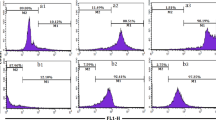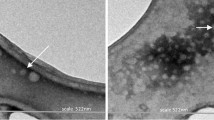Abstract
Pectobacterium carotovorum was incubated in formulations of chitosan nanoparticles or thyme essential oil-loaded chitosan nanoparticles for a maximum period of 48 h time. The cellular changes and viability were evaluated by transmission electron microscopy (TEM), and two colorimetric assays 3-(4,5 dimethylthiazol-2-yl)-2,5diphenyl tetrazolium bromide (MTT) and alamar blue (AMB), respectively. The incubation time and the addition of the secondary metabolite to the formulation were key factors to the cell damage and cell inhibitory effects on P. carotovorum, TEM observations overall demonstrated on the treated bacterium, cell surface alterations such as deforming and disappearance of the cell wall and the plasmatic membrane, with agglomeration of nanoparticles outside and inside of the cells, loss of cell content and lysis. Cell viability was reduced about 80% (MTT) and 100% (AMB) in the applied treatment of chitosan-loaded thyme essential oil nanoparticles after 48 h incubation, in addition, the total cell inhibition was shown from 6 h incubation onwards with the AMB assay. The TEM micrographs and the cell viability assays provided enough evidence of the antimicrobial activity of the nanostructured formulations compared with the control where no damage was observed.




Similar content being viewed by others
References
Al-Nasiry S, N.Geusens N, Hanssens M, Luyten C, Pijnenborg R (2007) The use of alamar blue assay for quantitative analysis of viability, migration and invasion of choriocarcinoma cells. Hum Reprod 22:1304–1309
Angius F, Floris A (2015) Liposomes and MTT cell viability assay: an incompatible affair. Toxicol In Vitro 29:314–319
Chauhan A, Kang S (2014) Thymol disrupts the membrane integrity of Salmonella ser. typhimurium in vitro and recovers infected macrophages from oxidative stress in an ex vivo model. Res Microbiol 7:559–565
Chen F, Shi Z, Neoh KG, Kang ET (2009) Antioxidant and antibacterial activities of eugenol and carvacrol-grafted chitosan nanoparticles. Biotechnol Bioeng 104:30–39
Góngora-Landeros E, Uría-Galicia E, Martínez-Jerónimo F, López-Villegas E (2010) Descripción histológica de la cámara incubatriz de Moina hutchinsoni (Brem, 1937). Int J Morphol 28:1025–1030
Joe MM, Benson A, Saravanan VS, Sa T (2015) In vitro antibacterial activity of nanoemulsion formulation on biofilm, AHL production, hydrolytic enzyme activity, and pathogenicity of Pectobacterium carotovorum sub sp. Carotovorum. Physiol Mol Plant Pathol 91:46–55
Li XF, Feng XQ, Yang S, Fu GQ, Wang TP, Su XZ (2010) Chitosan kills Escherichia coli through damage to be of cell membrane mechanism. Carbohydr Polym 79:493–499
Lv F, Liang H, Yuan Q, Li C (2011) In vitro antimicrobial effects and mechanism of action of selected plant essential oil combinations against four food-related microorganisms. Food Res Int 44:3057–3064
Mith H, Duré R, Delcenserie V, Zhiri A, Daube G, Clinquart A (2014) Antimicrobial activities of commercial essential oils and their components against food-borne pathogens and food spoilage bacteria. Food Sci Nutr 2:403–416
Mohammadi A, Hashemi M, Hosseini SM (2016) Effect of chitosan molecular weight as micro and nanoparticles on antibacterial activity against some soft rot pathogenic bacteria. LWT Food Sci Technol 71:347–355
Pettit RK, Weber CA, Kean MJ, Hoffmann H, Pettit GR, Rui Tan R, Franks KS, Horton ML (2005) Microplate alamar blue assay for Staphylococcus epidermidis biofilm susceptibility testing. Antimicrob Agents Chemother 49:2612–2617
Sarwar A, Katas H, Zin N (2014) Antibacterial effects of chitosan-tripolyphosphate nanoparticles: impact of particle size molecular weight. J Nanopart Res 16:2517
Sotelo-Boyás ME, Valverde-Aguilar G, Plascencia-Jatomea M, Correa-Pacheco ZN, Jiménez-Aparicio A, Solorza-Feria J, Barrera-Necha L, Bautista-Baños S (2015) Characterization of chitosan nanoparticles added with essential oils. In vitro effect on Pectobacterium carotovorum. Rev Mex Ing Quim 3:589–599
Stockert J, Blázquez-Castro A, Canetea M, Horobin RW, Villanueva A (2012) MTT assay for cell viability: Intracellular localization of the formazan product is in lipid droplets. Acta Histochem 114:785–796
Sumantran VN (2011) Cellular chemosensitivity assays: an overview. Methods Mol Biol 73:219–236
Wang C, Zhi-Luo D, Zhi-Ming X, Xin-Yi C, Ji-Wei C, De-Xin K, Bao-Ju L, Zhang H, Ling-Ling C (2015) Construction of a genome-scale metabolic network of the plant pathogen Pectobacterium carotovorum provides new strategies for bactericide discovery. FEBS Lett 589:285–294
Wattanasatcha A, Rengpipat S, Wanichwecharungruang S (2012) Thymol nanospheres as an effective anti-bacterial agent. Int J Pharm 434:360–365
Wen Y, Yao F, Sun F, Tan Z, Tian L, Xie L, Song Q (2015) Antibacterial action mode of quaternized carboxymethyl chitosan/poly (amidoamine) dendrimer core–shell nanoparticles against Escherichia coli correlated with molecular chain conformation. Mater Sci Eng C 48:220–227
Xing K, Chen X, Kong M, Liu C, Cha D, Park H (2009) Effect of oleoyl-chitosan nanoparticles as a novel antibacterial dispersion system on viability, membrane permeability and cell morphology of Escherichia coli and Staphylococcus aureus. Carbohydr Polym 76:17–22
Xue J, Davidson PM, Zhong Q (2015) Antimicrobial activity of thyme oil co-nanoemulsified with sodium caseinate and lecithin. Int J Food Microbiol 210:1–8
Yan F, Dang Q, Liu C, Yan J, Wang T, Fan B, Cha D, Li X, Liang S, Zhang Z (2016) 3,6-O-[N-(2-Aminoethyl)-acetamide-yl]-chitosan exerts antibacterial activity by a membrane damage mechanism. Carbohydr Polym 149:102–111
Zhang H, Jung J, Zhao Y (2016) Preparation, characterization and evaluation of antibacterial activity of catechins and catechins–Zn complex loaded-chitosan nanoparticles of different particle sizes. Carbohydr Polym 137:82–91
Acknowledgements
The authors acknowledge the financial support of the Secretary of Research and Postgraduates of the National Polytechnic Institute, through the project SIP-20160468 and Dr. Eva Ramón-Gallegos and Rocío Cruz-Muñoz of the National Polytechnic Institute for the technical guidance of the cell viability assays.
Author information
Authors and Affiliations
Corresponding author
Ethics declarations
Conflict of interest
The authors declare that they have no competing interest.
Ethics and consent to participate
This study did not involve humans, human data or animals; no ethics approval or consent is required to publish the results.
Additional information
Communicated by Erko Stackebrandt.
Publisher’s Note
Springer Nature remains neutral with regard to jurisdictional claims in published maps and institutional affiliations.
Rights and permissions
About this article
Cite this article
Sotelo-Boyás, M.E., Correa-Pacheco, Z., Corona-Rangel, M.L. et al. Cellular alterations in Pectobacterium carotovorum treated with nanostructured formulations during the incubation time. Arch Microbiol 201, 615–622 (2019). https://doi.org/10.1007/s00203-019-01628-w
Received:
Revised:
Accepted:
Published:
Issue Date:
DOI: https://doi.org/10.1007/s00203-019-01628-w




